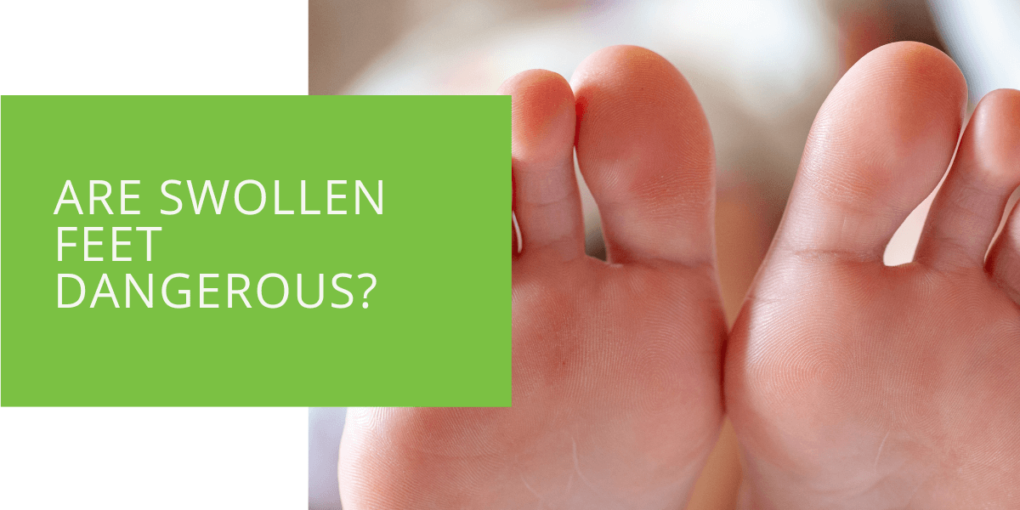Are Swollen Feet Dangerous?
Swelling in the feet and ankles, also known as peripheral edema, is a common condition that affects many people. It occurs when excess fluid accumulates in the tissues, causing them to swell. While swelling is not serious in most cases, it can sometimes indicate an underlying health condition. This article will discuss the possible causes of swollen feet and ankles when it is a cause for concern and what you can do to prevent and treat this condition.
Causes of Swollen Feet
Various factors can cause swelling. One of the most common causes is prolonged sitting or standing, which can lead to fluid accumulation in the lower limbs. This swelling is usually temporary and goes away after resting and elevating the feet.
However, there are also other possible causes of foot and ankle swelling, including:
Injuries
An injury, such as a sprain or fracture, can cause swelling. This type of swelling is usually accompanied by pain and tenderness.
Infections
Infections in the foot or ankle, such as cellulitis or athlete's foot, can cause swelling, redness, and warmth in the affected area. An infection can lead to systemic symptoms, such as fever and chills in severe cases.
Medical conditions
Several medical conditions can cause swelling. These include:
- Heart failure: Heart failure occurs when the heart cannot pump blood effectively, causing fluid to accumulate in the body, including the feet and ankles. This type of swelling is usually accompanied by shortness of breath, fatigue, and rapid weight gain.
- Kidney disease: Kidney disease can cause fluid retention in the body, leading to swelling in the feet, ankles, and legs. Other symptoms of kidney disease include high blood pressure, changes in urine output, and fatigue.
- Liver disease: Liver disease can also cause fluid retention in the body, leading to swelling. Other symptoms of liver disease include jaundice, nausea, and abdominal pain.
- High blood pressure: High blood pressure can damage the blood vessels in the body, causing fluid to leak into the surrounding tissues, including the feet and ankles.

Pregnancy
Pregnancy can cause swelling in the feet and ankles, particularly in the third trimester. This type of swelling is usually mild and goes away after giving birth.
Medications
Certain medications, such as antidepressants and blood pressure drugs, can cause swelling as a side effect.
Symptoms of Swollen Feet and Ankles
In addition to swelling, foot swelling can also cause other symptoms, such as:
- Redness
- Warmth
- Pain
- Numbness
- Tenderness
The presence of these symptoms can indicate whether the swelling is dangerous or not. For example, if you have swelling in one leg only, sudden and severe swelling, or swelling accompanied by pain and redness, you should seek medical attention immediately.
When to Seek Medical Attention
In general, swelling is not a cause for concern, particularly if it is mild and goes away after resting and elevating the feet. However, there are some circumstances in which you should seek medical attention for swelling, including:
- Swelling in one leg only: If swelling in one leg only, it may be a sign of a blood clot, also known as deep vein thrombosis (DVT). DVT can be a serious condition that requires prompt medical attention.
- Sudden and severe swelling: If you experience sudden and severe swelling in the feet and ankles, it may be a sign of an underlying medical condition, such as heart failure or kidney disease.
- Swelling accompanied by pain and redness: If you have swelling in the feet and ankles accompanied by pain and redness, it may be a sign of an infection or injury.
- Swelling that lasts for an extended period: If your swelling lasts for an extended period, it may be a sign of an underlying medical condition, such as heart failure, liver disease, or kidney disease.
- Difficulty breathing: If you experience difficulty breathing along with the swelling, it may be a sign of a serious medical condition, such as heart failure or pulmonary edema.
If you experience any of these symptoms, it is important to seek medical attention immediately.

Prevention and Treatment of Swollen Feet
Fortunately, several ways exist to prevent and treat foot swelling. These include:
- Exercise: Regular exercises, such as walking or cycling, can help improve leg circulation and reduce the risk of swelling.
- Maintaining a healthy weight: Maintaining a healthy weight can help reduce the strain on the legs and feet, reducing the risk of swelling.
- Wearing comfortable shoes: Wearing comfortable shoes that fit well can help reduce the risk of swelling.
- Avoiding standing or sitting for extended periods: Taking regular breaks from standing or sitting for extended periods can help improve circulation and reduce the risk of swelling.
- Resting and elevating the feet: Resting and elevating the feet can help reduce swelling by allowing the excess fluid to drain away from the legs and feet.
- Using compression socks or stockings: Compression socks or stockings can help reduce swelling by applying pressure to the legs and feet, helping to improve circulation.
- Taking medication as prescribed: If your swelling is caused by an underlying medical condition, such as heart failure or kidney disease, your doctor may prescribe medication to help manage the condition and reduce swelling.
- Surgery (in severe cases): In severe cases of foot and ankle swelling, surgery may be necessary to remove excess fluid and reduce swelling.

Are Swollen Feet Dangerous?
In most cases, swollen feet are not dangerous. They can be managed with self-care measures, such as resting and elevating the feet, wearing comfortable shoes, and taking breaks from standing or sitting for extended periods. However, in some cases, swelling can indicate an underlying medical condition, such as heart failure, kidney disease, or deep vein thrombosis (DVT).
Therefore, it is important to pay attention to the symptoms of swelling and seek medical attention if you experience any of the following:
- Swelling in one leg only
- Sudden and severe swelling
- Swelling accompanied by pain and redness
- Swelling that lasts for an extended period
- Difficulty breathing
You can help prevent serious health complications associated with foot swelling by seeking prompt medical attention and following the recommended treatment plan.
Conclusion
In conclusion, foot and ankle swelling is a common condition caused by various factors. In most cases, it is not a cause for concern and can be managed with rest, elevation, and other self-care measures. However, if you experience any of the symptoms mentioned in this article, it is important to seek medical attention immediately. Taking steps to prevent and treat swelling can help reduce your risk of developing serious health complications.

